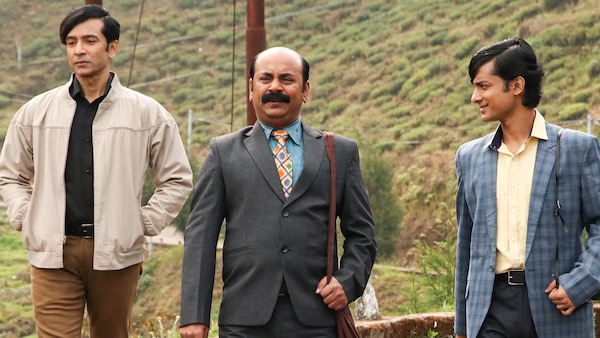Feludar Goyendagiri season 1 review: Srijit Mukherji recreates Ray’s nostalgia with another smart, sleek and sharp Feluda series
Anirban Chakrabarti as Jatayu often overshadows the leading characters by his star power and screen presence, at least in the first three episodes. But Tota Roy Chowdhury as Feluda definitely brings back his swag in the last three.

Last Updated: 10.18 PM, Jun 17, 2022
Story: The first season of the series is based on Satyajit Ray’s iconic Feluda novella, Darjeeling Jawmjawmat. Lalmohan Ganguly, aka Jatayu’s (Anirban Chakrabarti) filmmaker friend Pulak Ghosal (Rahul Banerjee), invites him and his friends Feluda (Tota Roy Chowdhury) and Topshe (Kalpan Mitra) to their shooting at Darjeeling. This is the second time the filmmaker chose Jatayu’s novel to make an action-packed Hindi film. (For those who are new to the Feludaverse, Pulak has earlier created another film based on Jatayu’s novel in Bombaiyer Bombete. The shooting takes place at a sprawling residence of Birupakhho Majumder (Barun Chanda) – a retired banking honcho. Midway, Birupakhho is stabbed to death.
Feluda gets into action and unfolds the dark truths of the victim’s life with his faithful ‘magajastra’ or the power of his grey cells. The final curtain is drawn in the presence of the shooting team with the hero Rajen Raina (Shaheb Bhattacharjee), villain Mahadev Verma (Subrat Dutt), heroine Suchandra (Mummun Roy) and the director.
Review: Srijit’s particular way of making Feluda is characterized by the old-fashioned Satyajit’s way of creating teen-targeted Feluda films with touches of creative ingenuity. He has earlier made Chhinnamastar Abhishap (and also unreleased Joto Kando Kathmandute) for Addatimes in a similar style of following the original text. The difference between Ray's films – Sonar Kella and Jai Baba Felunath – and Srijit’s storytelling is that the latter focuses on making the film a whodunit rather than a Ray-styled thriller. In certain ways, it is a safer way to make the story more intriguing to the audience.
Like Chhinnamasta, Darjeeling Jawmjawmat too is a period piece. Unlike the real-time overcrowded Darjeeling Mall, the film shows empty spaces where the clock tower can be seen from the famous Keventers. The cars, costumes, luggage and the near-empty hill station indeed give a retro look to the film.
The story moves rapidly and enjoyably with Feluda, Topshe and Lalmohan Babu. The racy deal starts from the last bit of the third episode when Bipurakhho dies. The director has used cliffhangers at the end of every episode since then and that keeps us glued.
Among the stars who have played Feluda on screen besides Soumitra Chatterjee, Tota is the one who is placed fittingly in the present times, for his useful combination of brains and brawn. We see him practising sirsasana and mayurasana – pretty much how Ray has portrayed the character in the books. While Anirban engages the audience with his wit and humour in the first three episodes as Jatayu, Tota comes back in full swag in the last three. His cold threats to the suspects, his frawnings and his confidence to catch the killer make him a very likeable Feluda indeed.
Meanwhile, it is a treat to watch Anirban on screen. It is not just his appearance that helps him play Lalmohan Ganguly, he has brought in his own skill sets to make the character contemporary and convincing. Jatayu shines bright as the sidekick of Felu Mitter as the young Topshe. Kalpan Mitra has matured as an actor over the last couple of years and after the initial fumbles in Chhinnamasta, he appears to be pretty effortless as Topshe in this series. In the acting department, it is important to mention Rahul Banerjee’s performance as Pulak Ghoshal. The character has comical shades and the actor performs splendidly in the show. He is natural and spontaneous in successfully carrying out the task of performing the role of the questionably talented director who has made some Bombay-style song-and-dance films and is going forward once again in making a movie based on Jatayu’s novel.
Satyajit Ray fastidiously avoided female characters in his Feluda series, as well as in other children's literature. Srijit too uses Suchandra, the heroine from Bombay, no more than a flower vase.
The series uses a common title track that is penned by Srijato and composed by Joy Sarkar, based on Ray’s original Feluda tune. It is wonderfully sung by Silajit, Sidhu and Anindya Chattopadhyay and one can avoid skipping the intro to watch the animation of old Feluda sketches by Ray from the books and the song. Darjeeling looks better when it looks empty and Ramyadip Saha captures it well. The car chase scenes on Pankhabari Road, though overkilled by Darjeeling-loving filmmakers in Tollywood, are nice. Also, the shot in which Feluda is pushed to the abyss is thrilling. A special mention must be given to the art direction for the way of using tiny retro details.
Verdict: In sum, the series is quite satisfactorily well directed, acted and plotted, despite minor deficiencies. Srijit’s Feluda remains true to the story in which Ray’s creativity dominates the storyline, and look and feel. One interesting feature needs to be pointed out in passing; the series is special in the sense that unlike regular web series content on the OTT platforms which are almost exclusively often enjoyed only by adults, here is something that the whole family may take pleasure in.
WHERE
TO WATCH
Subscribe to our newsletter for top content, delivered fast.
